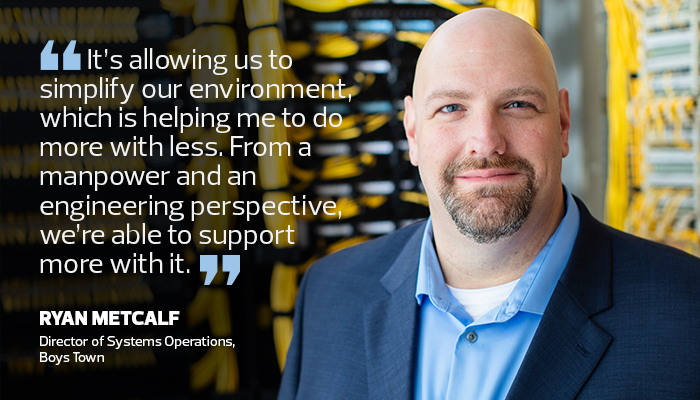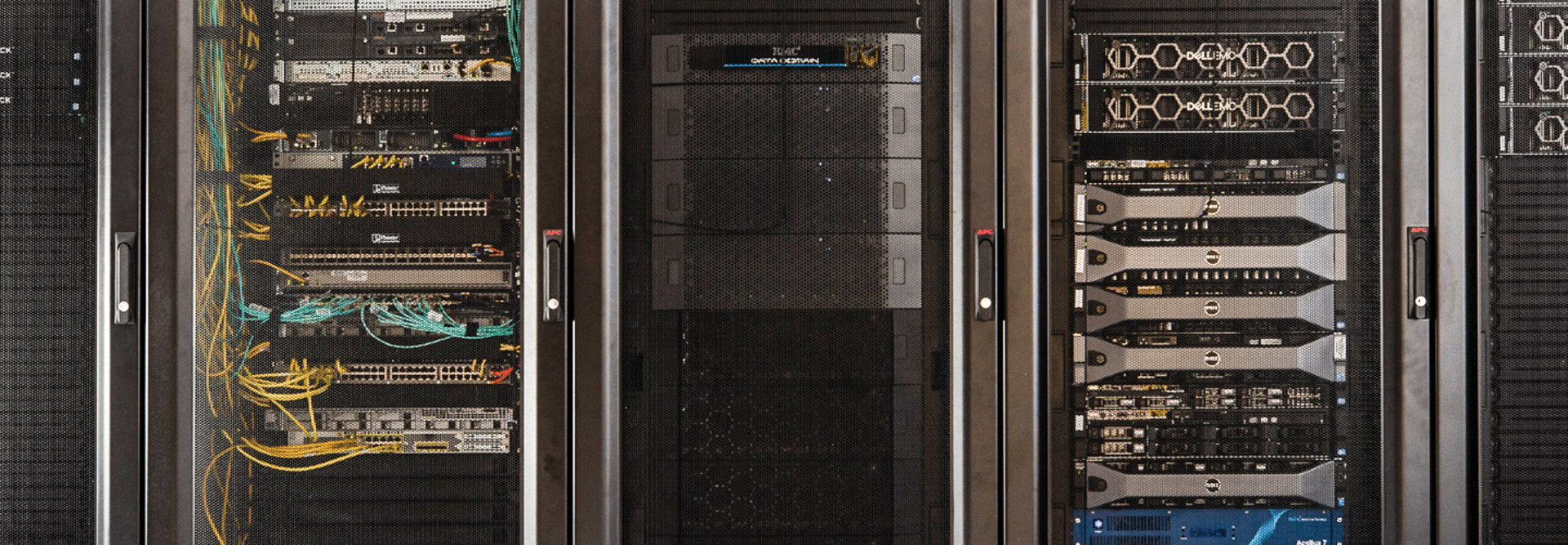Ryan Metcalf, director of systems operations for Boys Town, a nonprofit based in Omaha, Neb., jokes that IT ages in “dog years,” meaning that equipment seems to grow 7 years older every time the calendar turns over. When it came time for the organization to refresh its data center infrastructure, Metcalf was careful to consider the future.
“We were very wary about putting in technology that was ‘same old, same old,’” says Metcalf. “You don’t want to be putting in yesterday’s technology.”
Boys Town has been providing life-changing care for youth and families for more than 100 years. In 2017, Boys Town impacted more than 500,000 children across the United States through residential, nonresidential and healthcare programs, including Boys Town National Research Hospital, the Boys Town National Hotline and In-Home Family Services.
Ultimately, it went with hyperconverged infrastructure, deploying Dell EMC VxRack Flex and VMware vSAN.
“There were a number of different reasons we decided to go that route,” Metcalf says. “Number one is the diversity of having two different storage systems. Even though we previously had traditional storage area networks in our environment, we’ve always had at least a couple of them. That way, when we updated one with the latest software or patches, if we saw any problems, we didn’t have all our eggs in one basket.”
The hyperconverged infrastructure gives Boys Town the ability to grow at its own pace, cuts operating costs and provides flexibility in case the nonprofit decides to push more workloads to the public cloud.
“Anything that requires lower latency or higher IOs, we would hand-serve that with VxRack Flex,” says Metcalf. “And anything else, we put on vSAN. It’s a way to make sure we’re able to serve the needs of our different customers in a way that keeps us very wise with our money.”

A data center build-out requires IT and business leaders to strike a delicate balance — perhaps more now than ever before. On one hand, organizations can’t simply leave legacy infrastructure in place after equipment ages out of support contracts and becomes unreliable and expensive to maintain. On the other, it can be tempting to overspend during a refresh, as data center administrators may worry that funding won’t be available when they need additional resources. And the cloud throws another wild card into the mix: While most organizations purchasing on-premises resources have chosen not to place resources in the public cloud for good reasons, technology changes quickly, and companies need to maintain the freedom to pivot.
Bruce A. Taylor, executive vice president at DatacenterDynamics, says that organizations making on-premises investments need to do so in a way that not only has the potential to integrate with the public cloud, but also in a way that mimics the cloud’s benefits. “Most people are going to figure out how to migrate from their legacy systems to something that gives them much greater performance and agility,” he says.
VIDEO: Is the data center dying?
Data Center Investments Let Businesses Do More with Less
To win approvals for data center investments, IT leaders often have to make a compelling business case. Metcalf says that Boys Town was able to reduce its storage costs by 40 percent by moving from flash storage to hyperconverged infrastructure. The refresh also allowed Boys Town to consolidate its financial and human resources database on two physical nodes. That move alone, Metcalf says, is saving the organization about 30 percent per year in licensing costs.
“It’s allowing us to simplify our environment, which is helping me to do more with less,” Metcalf says. “From a manpower and an engineering perspective, we’re able to support more with it. We’re able to grow at the right pace with our business. And we’re able to provide the business with what they need at a very, very fast turnaround. I’m able to order and spin up resources in weeks, rather than months.”
A reduced time to market was also a draw for Draper, a not-for-profit research and development laboratory based in Cambridge, Mass. Draper recently consolidated the infrastructure supporting its Embedded Systems Group, which handles highly sensitive data for government and military work. Regulations require each system to be isolated, and until recently, the group maintained separate physical infrastructure to support dozens of programs. “If you can think of 50 small businesses running within the Draper building, that gives you an idea of what the Embedded Systems Group is in charge of,” says Gurinder Saini, director of infrastructure and operations.
Draper’s IT team now provides three options for the Embedded Systems Group: bronze (Dell EMC PowerEdge VRTX), silver (Dell EMC VxRail) and gold (Dell EMC VxRack Flex). The solutions allow Draper to consolidate infrastructure while helping it ensure compliance and security. Saini says the move was spurred by an organizational desire to transform the data center from an overhead expense into a business enabler.
“It’s about making operations more efficient, and about what can give us a competitive edge on some of these proposals,” Saini says. “If we say, ‘We can onboard your system in 30 days,’ and our competitors are stuck with the old ways of doing things, that gives us an edge.”
The modernization effort also reduced the physical footprint of Draper’s infrastructure, freeing up more space for employee offices — a huge win in the Boston real estate market. It also led to a dramatic reduction in maintenance needs. “We were spending 10 hours a week on updates,” says Saini. “We have reduced that to an hour a week.”
When Callaway Golf moved away from a colocation vendor and invested in on-premises infrastructure, the play was mostly about cost savings, says Sai Koorapati, vice president of global IT.
The company deployed four Lenovo System x3950 X6 servers to run its SAP HANA database, as well as eight Lenovo System x3850 M5 servers for its SAP application servers (which run virtualized on VMware).
Koorapati says the new infrastructure has also dramatically improved performance — which, in turn, has improved business productivity. Where reporting used to take a full day, Callaway now has access to real-time information that helps them better allocate resources and speed up product delivery.
“We have a dashboard in our warehouse, a real-time dashboard that shows red, green and yellow — for how units are moving on the conveyer,” Koorapati says. “The supervisor on the floor can see that there are more packages waiting in a location with not enough workers, and can send someone to where that location is red.”
MORE FROM BIZTECH: See what impact 5G will have on the data center!
Businesses Stay Flexible with a Mix of Cloud and On-Prem
While Boys Town, Draper and Callaway all invested in on-premises resources, they’re keeping an eye on the shifting IT landscape. “For us, it was really simple math, and the conclusion was that bringing infrastructure in-house was much more cost-effective,” says Koorapati. “We’re not 100 percent on-prem. We have Software as a Service. When we decide to bring in a new solution, we discuss: Should we bring it on-premises, or should it be a cloud service?”
“We’re looking at the future,” says Saini. “A lot of people are going to the cloud. The challenge we have with Draper workloads is that they’re often classified, and there are a lot of requirements around classified data in the cloud."
But that doesn’t mean everything is classified.
Virtualization is the first step in that journey that will allow us to shift those workloads offsite as we have more options available for approved cloud providers.” Metcalf says Boys Town is “not ready” to significantly shift resources to the public cloud.
“It is something that we’re aware of, and we’re marching toward that,” he says. “I don’t see Boys Town going 100 percent cloud, but I definitely see certain times of the year when it might make sense to push certain workloads to the public cloud, depending on our needs. But we’re building a solid foundation so that, if we want to move workloads into the public cloud and back, we’re going to be able to do that very, very seamlessly.”
For now, Metcalf says, he’s happy with the performance and cost of the organization’s new data center investments. “With the money I’m saving for next year’s budget, I’m able to do other projects and advance us in other areas,” he says. “But it’s very key to understand your utilization today, and to understand your growth and where you’re going. We’ve learned so much through that process, and we’re a more mature organization because of it.”












